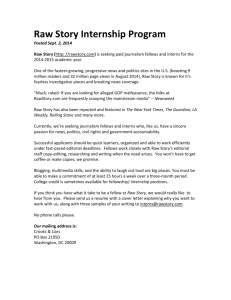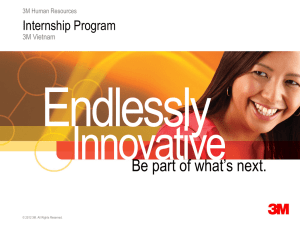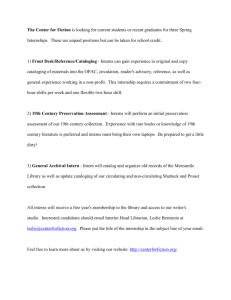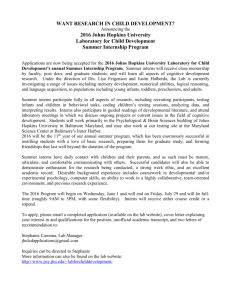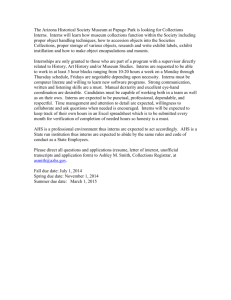A Case for Authentic Assessment: Nutrition and Dietetics Internship
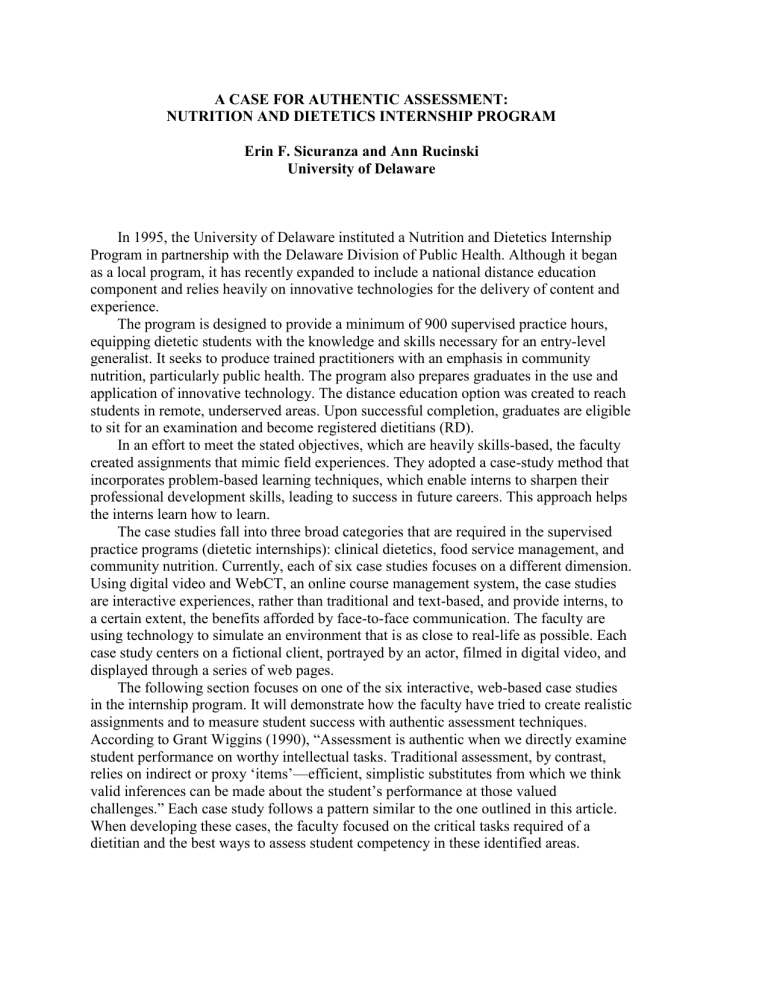
A CASE FOR AUTHENTIC ASSESSMENT:
NUTRITION AND DIETETICS INTERNSHIP PROGRAM
Erin F. Sicuranza and Ann Rucinski
University of Delaware
In 1995, the University of Delaware instituted a Nutrition and Dietetics Internship
Program in partnership with the Delaware Division of Public Health. Although it began as a local program, it has recently expanded to include a national distance education component and relies heavily on innovative technologies for the delivery of content and experience.
The program is designed to provide a minimum of 900 supervised practice hours, equipping dietetic students with the knowledge and skills necessary for an entry-level generalist. It seeks to produce trained practitioners with an emphasis in community nutrition, particularly public health. The program also prepares graduates in the use and application of innovative technology. The distance education option was created to reach students in remote, underserved areas. Upon successful completion, graduates are eligible to sit for an examination and become registered dietitians (RD).
In an effort to meet the stated objectives, which are heavily skills-based, the faculty created assignments that mimic field experiences. They adopted a case-study method that incorporates problem-based learning techniques, which enable interns to sharpen their professional development skills, leading to success in future careers. This approach helps the interns learn how to learn.
The case studies fall into three broad categories that are required in the supervised practice programs (dietetic internships): clinical dietetics, food service management, and community nutrition. Currently, each of six case studies focuses on a different dimension.
Using digital video and WebCT, an online course management system, the case studies are interactive experiences, rather than traditional and text-based, and provide interns, to a certain extent, the benefits afforded by face-to-face communication. The faculty are using technology to simulate an environment that is as close to real-life as possible. Each case study centers on a fictional client, portrayed by an actor, filmed in digital video, and displayed through a series of web pages.
The following section focuses on one of the six interactive, web-based case studies in the internship program. It will demonstrate how the faculty have tried to create realistic assignments and to measure student success with authentic assessment techniques.
According to Grant Wiggins (1990), “Assessment is authentic when we directly examine student performance on worthy intellectual tasks. Traditional assessment, by contrast, relies on indirect or proxy ‘items’—efficient, simplistic substitutes from which we think valid inferences can be made about the student’s performance at those valued challenges.” Each case study follows a pattern similar to the one outlined in this article.
When developing these cases, the faculty focused on the critical tasks required of a dietitian and the best ways to assess student competency in these identified areas.
C LARA H AYES : A C LINICAL D IETETICS C ASE S TUDY
This case study begins with a brief narrative on Clara Hayes, a 69 year-old woman who drives herself to the local hospital. She complains of shortness of breath, swollen ankles, and “just feeling poorly.” Upon admission, the nurse conducts a health history, nutrition screen, blood tests, and an EKG. Our students, serving as dietetic interns, are given additional background information in the overview and provided with questions to prepare them for the remainder of the case-study exercises.
In addition to the narrative overview, interns have access to Clara’s health history, her laboratory results, and the notes taken by the admitting nurse. The idea was to create a medical chart similar to those a student would face in the hospital. For more authenticity, the faculty secured permission to use actual forms from a regional healthcare management company. The forms were completed in longhand and scanned for students to access via the web (see Figure 1).
Figure 1a: Portion of Health History, page 1 of 3.
The interns are then asked to answer two questions and submit them via WebCT:
1.
What do you know about this patient before entering her room? Be specific.
2.
Is Clara at nutritional risk? If yes, explain why. If no, defend your position!
Faculty then assess whether or not the students are getting off to a good start.
Interns are also asked to complete several assignments prior to conducting the virtual consultation with Clara. For example, given Clara’s height and weight, interns must calculate her body-mass index (BMI) using an online calculator. They must identify the mechanism of action and any potential drug/nutrient interactions from a list of her current medications. These assignments are also submitted via WebCT to the program coordinators.
The compilation of these formative authentic exercises and assessments help to prepare interns for the next phase of the case study, the virtual consultation. Reviewing the submissions enables the faculty to determine whether or not the interns are on the right track at several points, thereby providing opportunities for critical intervention, if necessary.
Once students begin the consultation with Clara, they experience more self-reflective formative assessments, while progressing through the case. First, the intern is presented with two ways to begin the consultation. Based on that decision, a short video clip will reveal a reaction from the client. At its conclusion, the intern is given critical commentary about the selected choice. The interns may return to the decision point and revise their choice based on the commentary from the first attempt.
Throughout the consultation, interns are given many choices about how to proceed.
Following their decisions, interns will see Clara’s reactions on video and receive critical commentaries and summaries to help them gauge the appropriateness of their choices. At certain times in the case study, interns can access additional information, such as laboratory results, nurses’ notes, and questions.
As a summative assessment, interns are asked to complete and print out a Nutrition
Progress Report page, while they are on campus during the one-week orientation. Again, this page is an actual form used by a regional healthcare management company, scanned in portable document format (.pdf). To complete this progress report, interns must take into account all the information gathered from supporting materials and the virtual consultation. They are expected to discern which information is most appropriate for the report. According to the program faculty , students new to the field tend to provide too much information, and the coordinators help them winnow it down. In the end, interns present and discuss their completed reports in class.
A
SSESSMENT
Is this an effective way to prepare future dietitians? To answer this critical question, the program faculty conducted an evaluation of the six case studies with a group of twenty-five interns. They were asked to evaluate certain items using a Likert scale of 1-5
(1 = most positive; 5 = least positive). The questions evaluated the case studies based on ease of use, level of independence from the instructor, applicability to practice, realitybased orientation, scientific accuracy, and usefulness and adequacy of resources. Most students rated these items in the 1-2 response category, with very few responses of a 3 or more. Additionally, students were asked to rate their increase in confidence, ability to apply theory [in] to practice, and overall satisfaction. Again, the majority of the responses were in the 1-2 range.
Students also provided some qualitative feedback on the case study system that was generally very positive. They made comments, such as “Very realistic and pertinent to what we will be doing in the internship” and “As close to reality as you can get while being on a computer.” One student commented, “more videos and choices would make
the cases more realistic.” As a result, the faculty are developing four new virtual case studies that will be available this summer.
To continue our investigation into the effectiveness of this instructional model, the intern survey is being improved for the next session. The instrument will be broken into two parts: one that focuses on case study questions; the other will evaluate the consultations. This redesign will provide the interns with opportunities to give more indepth feedback relating to the two distinct segments of the case studies.
The program faculty have also created a peer review survey that was sent to over 200 nutrition and dietetic internship directors around the country. These directors were invited to take a tour of one case study and provide feedback via a web-based survey. The directors were asked to comment not only on the use of WebCT and video but the authenticity of the case and assignments as well. This study is ongoing, and results will be available in summer 2002.
The faculty also observed the “entertainment” value of the interactive case studies.
As the technology became more complex, interns were disappointed when they were presented cases with less complex and involved technologies. The faculty noted that the interns working in groups would approach the consultation several times, because they were interested to hear the clients’ various responses. Overall, the faculty found the virtual case study approach a useful tool in a dietetic internship orientation.
References:
B. Duch, S. Groh, and D. Allen. “Why Problem-Based Learning? A Case Study of
Institutional Change in Undergraduate Education,” in Duch, Groh, and Allen, eds., The
Power of Problem-Based Learning (Sterling, VA: Stylus Publishing, LLC, 2001).
C. Hamilton, A. Rucinski, and J. Schakelman, “Innovating Professional Development for
Future Health Care Practitioners,”
T.H.E. Journal 28, no. 11 (June 2001):79-87.
G. Wiggins, “The Case for Authentic Assessment,”
Eric Digest (1990); http://ericae.net/edo/ED328611.htm
.
Contacts:
Ann Rucinski, M.A., R.D., is the dietetic internship supervisor at the University of
Delaware. Ann has extensive experience as a community nutritionist, particularly in the area of health promotion. rucinski@udel.edu
Erin F. Sicuranza, M.Ed., is an instructional designer in Information Technologies-User
Services at the University of Delaware. Erin provides faculty support in the areas of curriculum design and incorporation of educational technologies. esicuran@udel.edu
